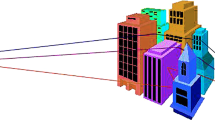Abstract
This paper deals with the distribution of cumulated instantaneous interference power in a Rayleigh fading channel for an infinite number of interfering stations, where each station transmits with a certain probability, independently of all others. If all distances are known, a necessary and sufficient condition is given for the corresponding distribution to be nondefective. Explicit formulae of density and distribution functions are obtained in the interesting special case that interfering stations are located on a linear grid. Moreover, the Laplace transform of cumulated power is investigated when the positions of stations follow a one- or two-dimensional Poisson process. It turns out that the corresponding distribution is defective for the two-dimensional models.
Similar content being viewed by others
References
N. Abramson, The throughput of packet broadcasting channels, IEEE, Trans. Comm. 25 (1977) 117–128.
T.M. Apostol,Mathematical Analysis, 2nd Ed. (Addison-Wesley, Reading, Mass., 1974).
E. Artin,Einführung in die Theorie der Gammafunktion (Teubner, Leipzig, 1931).
G. Doetsch,Anleitung zum praktischen Gebrauch der Laplace-Transformation und der Z-Transformation, 3rd Ed. (Oldenbourg, München, 1967).
W. Feller,An Introduction to Probability Theory and Its Applications (Wiley, New York, 1966).
M.G. Kendall and P.A.P. Moran,Geometrical Probability (Griffin, London, 1963).
K. Knopp,Theorie und Anwendungen der unendlichen Reihen (Springer, Berlin, 1964).
A.W. Marshall and I. Olkin,Inequalities: Theory of Majorization and Its Applications (Academic Press, New York, 1979).
R. Mathar and J. Mattfeldt, Analyzing routing strategy NFP in multihop packet radio networks on a line, Technical report, Aachener Informatik-Berichte, 92–8 (1992).
R. Mathar and D. Pfeifer,Stochastik für Informatiker (Teubner, Stuttgart, 1990).
R. Prasad, Performance analysis of mobile packet radio networks in real channels with inhibit-sense multiple access, Proc. IEE 138 (1991) 458–464.
R. Prasad and C.Y. Liu, Throughput analysis of some mobile packet radio protocols in Rician fading channels, Proc. IEE 139 (1992) 297–302.
H. Steffan, Leistungsanalyse von S-ALOHA Multihop-Netzen mit Diversitätsempfängern, in: B. Walke, O. Spaniol (eds.),Messung, Modellierung und Bewertung von Rechen- und Kommunikationssystemen, 7. ITG/GI-Fachtagung, Springer, Berlin, 1993.
H. Takagi and L. Kleinrock, Optimal transmission ranges for randomly distributed packet radio terminals, IEEE, Trans. Comm. 32 (1984) 246–257.
K. Trivedi,Probability & Statistics with Reliability, Queueing and Computer Science Applications (Prentice-Hall, Englewood Cliffs, 1982).
Author information
Authors and Affiliations
Additional information
This work was supported by the Deutsche Forschungsgemeinschaft under grant no. Ma 1184/2-3.
Rights and permissions
About this article
Cite this article
Mathar, R., Mattfeldt, J. On the distribution of cumulated interference power in Rayleigh fading channels. Wireless Netw 1, 31–36 (1995). https://doi.org/10.1007/BF01196256
Received:
Issue Date:
DOI: https://doi.org/10.1007/BF01196256




